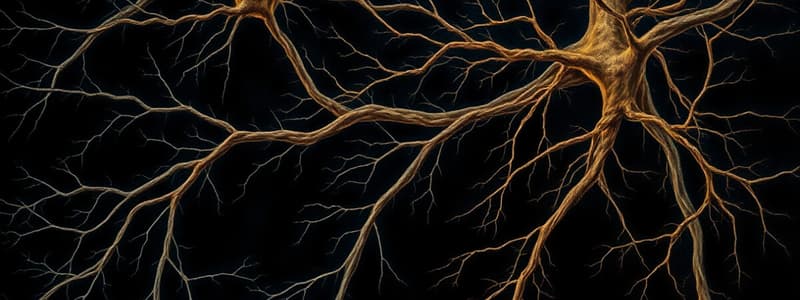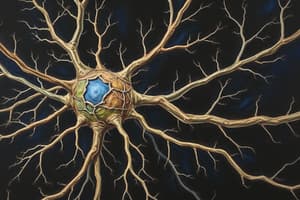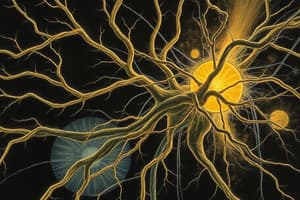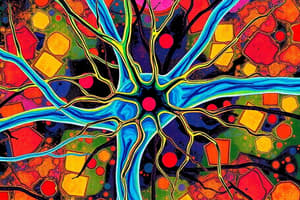Podcast
Questions and Answers
What is the primary function of oligodendrocytes within the CNS?
What is the primary function of oligodendrocytes within the CNS?
- Produce cerebrospinal fluid
- Remove excess neurotransmitters from synapses
- Myelinate axons to facilitate rapid signal transmission (correct)
- Provide structural support and repair nervous tissue
Which type of glial cell is primarily involved in forming the blood-brain barrier?
Which type of glial cell is primarily involved in forming the blood-brain barrier?
- Microglia
- Oligodendrocytes
- Astrocytes (correct)
- Ependymal cells
How are CNS glial cells distinct from PNS glial cells in terms of origin?
How are CNS glial cells distinct from PNS glial cells in terms of origin?
- CNS glial cells are primarily neuroepithelial in origin
- Both CNS and PNS cells derive from mesoderm
- CNS cells derive from mesoderm while PNS cells derive from ectoderm
- CNS glial cells originate from neuroectoderm, while PNS glial cells are of neural crest ectoderm (correct)
What characteristic cellular marker is found in astrocytes?
What characteristic cellular marker is found in astrocytes?
What is the role of microvilli on specialized ependymal cells?
What is the role of microvilli on specialized ependymal cells?
What is the primary role of microglia in the central nervous system?
What is the primary role of microglia in the central nervous system?
Which of the following statements about satellite cells is true?
Which of the following statements about satellite cells is true?
What distinguishes Schwann cells from oligodendrocytes?
What distinguishes Schwann cells from oligodendrocytes?
During an action potential, what triggers the activation of voltage-gated Na+ channels?
During an action potential, what triggers the activation of voltage-gated Na+ channels?
What type of cell is involved in the development of Guillain-Barré syndrome?
What type of cell is involved in the development of Guillain-Barré syndrome?
Flashcards
Neurons
Neurons
Permanent cells in the nervous system that transmit signals.
Nissl staining
Nissl staining
A staining technique that reveals dendrites and cell bodies, but not axons.
Astrocytes
Astrocytes
The most abundant glial cells in the CNS, supporting neurons and maintaining the blood-brain barrier.
Oligodendrocytes
Oligodendrocytes
Signup and view all the flashcards
Myelin
Myelin
Signup and view all the flashcards
Microglia activation
Microglia activation
Signup and view all the flashcards
Microglia function
Microglia function
Signup and view all the flashcards
Neuron action potential
Neuron action potential
Signup and view all the flashcards
Resting membrane potential
Resting membrane potential
Signup and view all the flashcards
Satellite cells
Satellite cells
Signup and view all the flashcards
Study Notes
Nervous System Cells
- Neurons are signal-transmitting cells with dendrites (input), cell bodies, and axons (output)
- Dendrites and cell bodies stain with Nissl stain, axons do not
- Neurofilament protein and synaptophysin are neuron markers
- Astrocytes physically support neurons, repair, remove excess neurotransmitters, and form part of the blood-brain barrier
- Astrocytes store glycogen and buffer ions
- GFAP is an astrocyte marker
- Oligodendrocytes myelinate axons in the central nervous system (CNS)
- Oligodendrocytes also called "fried egg" appearance historically
- Each oligodendrocyte can myelinate multiple axons (aprox. 30)
- Ependymal cells are ciliated columnar cells lining ventricles and spinal cord central canals
- Ependymal cells circulate cerebrospinal fluid (CSF) and absorb it through microvilli
- Microglia are phagocytic cells in the CNS, responding to tissue damage by releasing inflammatory mediators
- Microglial activation involves releasing nitric oxide and glutamate
- Satellite cells surround neuronal cell bodies in ganglia
- Schwann cells myelinate axons in the peripheral nervous system (PNS)
- Each Schwann cell myelinates one axon
CNS Glial Cells
- CNS glial cells are derived from neuroectoderm, except microglia
- Myelin is a layered wrapping around axons that increases signal conduction speed
- Myelin increases transmission velocity
- Saltatory conduction occurs at nodes of Ranvier
- Astrocytes are the most abundant type of glial cell in the CNS
- Astrocytes play role in reactive gliosis, in response to neural injury
- Microglia are phagocytic cells, responding to tissue damage and infection
- Microglia can fuse to form multinucleated giant cells (as seen in HIV-associated dementia)
- Microglia are derived from mesodermal precursors
PNS Glial Cells
- PNS glial cells are derived from neural crest ectoderm
- Satellite cells surround neurons in peripheral ganglia, having a similar supportive role as astrocytes in the CNS
- Schwann cells myelinate axons in the peripheral nervous system
- A single Schwann cell myelinates one axon
Neuron Action Potential
- Resting membrane potential is more permeable to K+ than Na+
- Depolarization occurs with Na+ influx
- Na+ channel inactivates at peak potential
- Repolarization occurs with K+ efflux
- Hyperpolarization occurs due to slow K+ channel closure
- Na+/K+ pump restores ion concentration
Sensory Receptors
- Free nerve endings detect pain and temperature
- Meissner corpuscles detect light touch and low-frequency vibrations
- Pacinian corpuscles detect high-frequency vibrations and pressure
- Merkel discs detect sustained pressure and touch
- Ruffini corpuscles detect stretch and joint movement
Studying That Suits You
Use AI to generate personalized quizzes and flashcards to suit your learning preferences.




